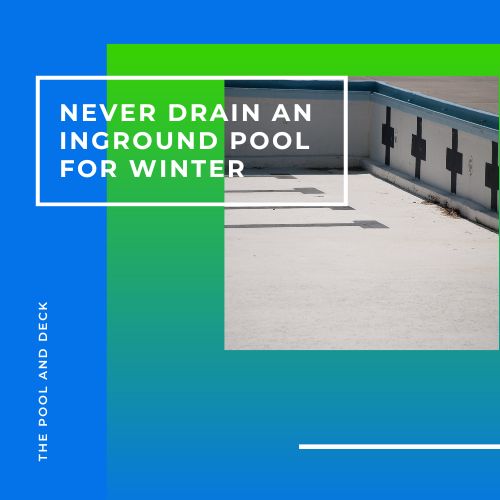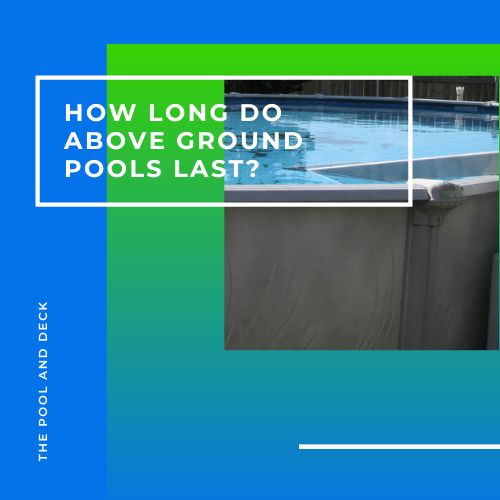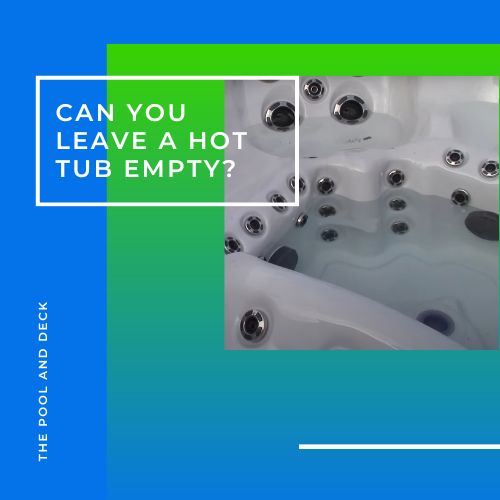5 Important Reasons to Never Drain an Inground Pool for Winter
As an Amazon Associate, I earn from qualifying purchases.
Table of Contents
Do You Drain an Inground Pool for the Winter?
Did you have an inground pool installed in your backyard this year? Or maybe you bought a house with an inground pool. I am sure you & your family had a great summer, swimming and splashing around in your pool. But now that winter is approaching it is natural for you to ask if you should drain your inground pool for the winter?
No. Never drain your pool completely. There are 5 important reasons why you should never completely drain your inground pool in preparation for winter.

Keeping the recommended level of water in the inground pool during winter is necessary for:
- Protecting the pool liner
- Keeping the pool water clean for next season
- Saving on water & expensive pool chemicals
- Preventing cracks in the pool wall
- Reducing the risk of pool wall collapse or pool “popping” out
You are required to close your inground pool for the winter. Closing a pool for winter is an elaborate process. If you are a new pool owner, you might consider using the services of a professional to close your pool for the winter.
One step in the process of closing the pool for the winter does require reducing the pool water level. However, you should never drain the pool completely.
So let me explain in more detail the reasons why you should never drain your inground pool completely for winter.
Pool Water Helps Keep the Pool Liner in Place
Pool liners are made from polymers such as vinyl. The vinyl liner in an inground pool stretches all the way from the shallow end to the deep end.
As you start draining the pool, the shallow end has little or no water, while the deep end still has some water. The weight of the water in the deep end exerts a “pull” on the vinyl liner in the shallow end.
This pull can cause the vinyl pool liner to stretch, distort or even tear. When you top up your pool with water in spring, the water will seep through the cracks in the pool liner and damage the pool wall and pool structural supports.
Draining the pool can result in pool liner damage. Pool liner repair & replacement is expensive. Damage to the pool wall & structural support will require even more costly repairs.
Pool Water Keeps the Pool Clean
It may seem that it will be easier to keep a completely empty pool clean with little effort. This is far from the truth.
Once the pool is completely empty you will not have easy access to the pool floor. Dust, dry leaves & twigs, dead insects & small animals will collect on the floor. Some rainwater, snow or ice melt will also find its way into the pool.
Using a solid pool cover will help. But trust me, you are not going to like the looks of the pool floor, when you remove the covers in spring.
If at all the pool can be cleaned up, it will require a huge amount of time, effort and money.
However if the pool contains the recommended amount of water for winter and you keep replenishing the pool chemicals, the pool water will remain fairly clean throughout the winter.
In the coming spring you will need to shock the pool and replenish pool chemicals. This is normal practice, anyway, when opening a pool. Your pool will be ready for a swim within a couple of days.
Draining the Pool is Expensive
Draining an inground swimming pool is not as simple as draining your bathtub. An average family swimming pool will have 20–30,000 gallons of water in it.
The first concern is where do you drain this water? Many local authorities have strict regulations on how and where pool water can be drained. The reason is the water in the pool has a fair amount of pool chemicals which can be harmful to the flora and fauna of the neighborhood.
Then there is the cost of draining the pool. And of course you will need to refill the pool too, after winter. FIXR estimates that the cost to drain a 30,000 gallon pool is $175 and the cost to refill it is between $120–300.
And do not forget that when you drain your inground pool for winter, you are throwing away expensive pool chemicals, along with the pool water. You will need to replenish all those chemicals in spring, when you refill your pool. That costs money!
The total cost of draining and refilling the pool (not that I recommend it) can be substantial.
Pool Water Protects the Pool Wall
Pool walls are designed to be under water. The pool wall material does not stand up very well to sunlight exposure.
Concrete Pools
Concrete pools have their interior walls lined with pool plaster, masonry, tiles or epoxy paint. None of these are designed for direct exposure to sunlight, large temperature variations, freeze-thaw cycles, etc.
The interior covering of a concrete inground pool may discolor, delaminate or crack when not under water. The cost of repairs of failing interior surfaces often tops the list on pool maintenance costs.
Fiberglass Pools
A drained and empty fiberglass pool is subject to hydrostatic pressure from the ground surrounding it. Fiberglass is a very strong material, stronger than concrete and steel, for the same thickness.
But there is a catch. Fiberglass pools use a relatively thin fiberglass pool shell. Under stress the shell can twist, bow or crack.
Pool Water Counters the Groundwater Hydrostatic Pressure
An empty or partially full inground pool is at a serious risk of either the pool walls collapsing inwards or the pool “popping” out of the ground.
The water in the pool exerts an outward pressure on the pool walls and the pool floor. The pool water, essentially, counters the inward hydrostatic pressure exerted by the groundwater. An equilibrium is maintained.
Remove the water from the pool and you disturb the equilibrium. The hydrostatic pressure exerted by the groundwater has no countering pressure from pool water. It will either make the pool walls cave in or make the pool floor pop out of the ground.
Can You Ever Drain Your Inground Pool?
I know I have said that you can never drain your inground pool completely for winter. So what is the point of raising the question again?
Let me clarify. You should never drain your inground pool completely for winter. I still stand by this statement.
However, a professional can, and will need to, drain the pool completely, at times.
A professional will drain the inground pool, most likely not in winter, and will refill it as soon as he can. Actually, the best time to drain a pool is spring, prior to the pool opening.
Draining the pool may become necessary for:
Periodic Deep Clean
A deep clean is often required every 5-7 years. Regular use of pool chemicals, brushing & vacuuming will keep your pool clean, only for so long.
A time will come when the water is “old” & contaminated. Regular pool maintenance begins to lose its efficiency. A pool professional may then advise you to go for a deep clean.
Take their advice and hire them to do the job. Don’t even think of attempting to do it yourself.
Restoring Pool Beauty
Irregular brushing & vacuuming, unbalanced pool water chemistry and chemicals in rain or top-up water are sooner or later going to stain your pool walls & floor. The pool will start looking jaded.
You may then opt to get your pool restored to its original beautiful look. Ask a quote from a professional pool restorer. They will drain the pool, perform an acid wash, refinish pool surfaces, make minor repairs, etc.
You can have your pool looking as good as new!
Major Pool Repairs
Major pool problems are not in your control. Breakdowns and malfunctions of equipment & assets are a part of life. Grin & bear it!
Ask your pool service agency if the repair can be done without draining the pool. Minor repairs can usually be done without a full pool drain. However, for bigger issues related to plumbing or large cracks, you may not have an option.
Thank you very much for reading the post. I do hope you found it informative and helpful.






